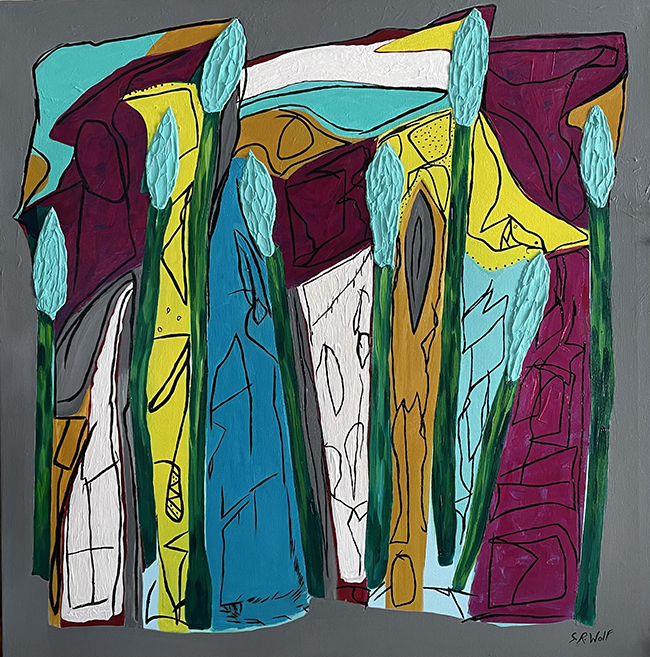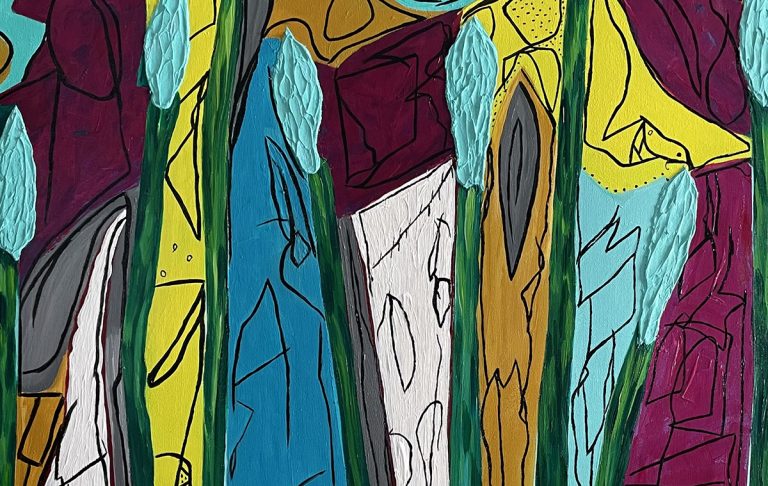Born in 1956 in Santa Monica, California, Susie Rosso Wolf—often signing her work as SR Wolf—has lived a life shaped by the pull of place and memory. She grew up under the wide blue skies of the West Coast before finding her true rhythm far from the coastlines, tucked into the quiet beauty of rural Montana. Her time at the California Institute of the Arts (CalArts) laid the technical foundation, but it was her later years, surrounded by fields and big open skies, that gave her work its heart.

Wolf’s paintings reach back through time, pulling forward the pieces that matter most—small moments, simple joys, echoes of family. Her work isn’t built on grand statements or big gestures. It’s intimate. Honest. Every canvas is a kind of homecoming, a journey back to the people and places that shaped her. Her art feels less like something made and more like something remembered.
The Work: Rosann’s Vases
Rosann’s Vases isn’t just about glass and flowers. It’s about a feeling—a childhood memory wrapped in light and love.
The story behind the painting starts in the late 1960s and early 70s, a time Wolf holds close. She remembers her mother, Rosann Rosso, turning their backyard into a kind of personal paradise. It wasn’t just a garden. It was a sanctuary—a place full of life, color, and calm, built with the intention of surrounding the family with beauty.
Wolf’s part in this world was small but important. She would gather the long-stemmed flowers from the garden and carry them carefully into the house. Her job was to place them in her mother’s collection of Italian vases, bought lovingly by her father. These weren’t ordinary vases. They were beautiful, colorful, delicate, many with bubbles caught inside the glass like frozen moments.
The shelf above the stove and kitchen counters held all of them—a parade of color and light. Flowers filled them, spilling into the air. It’s a scene etched into Wolf’s mind, sharpened even more by the loss of her mother in 1977.
In Rosann’s Vases, that memory doesn’t come back clean or literal. It surges out in Wolf’s intuitive, abstract style. Shapes blend and drift. Colors hum together. There’s no strict realism. Instead, there’s feeling—warmth, nostalgia, a small ache for the beauty of things past. You don’t see a backyard or a kitchen shelf in the painting, but you feel the presence of both. The way memory doesn’t keep things neat, but alive.
Wolf talks about how, in many of her paintings, memories of her mother jump onto the canvas almost without her trying. They come in sideways—through a flash of color, the arc of a line, the glow of light caught on a brushstroke. Rosann’s Vases is built on that same kind of muscle memory. It’s less a planned tribute, more a return to a place of wonder, beauty, and deep, enduring love.
What’s powerful about Rosann’s Vases isn’t just the personal history behind it. It’s the way Wolf gives viewers a way into their own memories. You don’t have to know the specifics—her mother’s name, the color of the kitchen wall, the smell of the flowers. The painting opens the door wide enough for anyone to step through. It’s about the universal truth that the simplest things—an afternoon, a vase, a stem of flowers—are the ones that stay with us the longest.
In the end, Rosann’s Vases is less about grief and more about gratitude. It’s not a painting of what was lost. It’s a painting of what was given, what remains, what still fills the air like perfume long after the flowers are gone.
Wolf’s work, like her memories, doesn’t shout. It doesn’t demand.
It offers.
And in that quiet offering, it carries something lasting.


